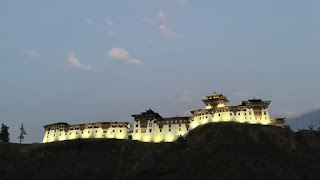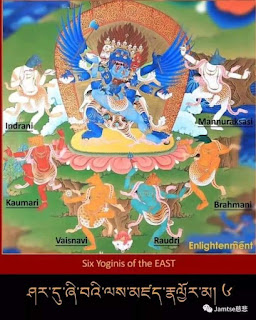THE LEGEND OF NYALA DUEM
BY TSHERING TOBGAY
As you travel from Wangduephodrang to Trongsa, right after crossing the Jarukhashor Choeten at Chendebji, you will come across a big forest called Nyalalum. It is believed that, long ago, a malevolent demoness known as Nyala Duem made this forest her dwelling. She was the eldest of the seven siblings.
One demoness dwelled at Tergang, another on the way from Trongsa to Jakar Dzong, another roamed Takrinang which lies between Phobjikha and Athang, the next dwelled in Thurmangja, and the other one set up her residence at Chuser Lungpa between Rukubji and Chendebji. The sixth sibling dwelled at Dzongkha Lungpa below Trongsa Dzong and the seventh sibling, a demon named Gup Lakdum, dwelled below Tshangkha.
Nyala Duem was the most malevolent of the seven siblings and she could display various magical illusions. Sometimes, she transformed herself in broad daylight and harmed people. At times, she would transform into various animals. At other times, she would take the form of a human and pretend to help people at work. Occasionally, she she would turn into things.
Among many such accounts, Tashi Delek will run a series on verbal narratives passed down from generations.
AN EPISODE: GARP LUNGI KHORLO
Long ago, during the fortunate kalpa (eon), human beings, local deities and dharma protectors interacted and travelled together. It was the time when famous local deities like Ap Chundu of Haa, Ap Geynyen of Thimphu, and Ap Muktsen of Trongsa were known to father children with local women.
Among the followers of Ap Muktsen, the three brothers - Geypung Norbu, Gyetsel Rigpa and Garp Lungi Khorlo - made names for themselves and grew widely famous. Fearing rebellion from the three brothers if not brought under control, Trongsa Penlop Zhidhar (Druk Dhendup took them as novices under his command.
Since the three of them were stronger, more intelligent and forceful by nature, it was not long before no one in the ranks of the attendants could look them in the eye. The Trongsa Penlop thought that his authority could be challenged if each of them was not tamed tactfully. He decided to discipline Garp Lungi Khorlo, whose name means the wheel of wind, first.
He made the three heroes bet among themselves – Geypung Norbu would rub down an iron hammer into an axe in one day, Gyetsel Rigpa was tasked to stitch a costume for mask dance out of a sack of silk shreds in one day, and Garp Lungi Khorlo was to walk from Trongsa to Punakha and back in one day. The Trongsa Penlop promised to honour them with promotion if they succeeded in their tasks.
As ordered, Garp Lungi Khorlo made it back to Trongsa from Punakha before dinner was over at Trongsa Dzong. He noticed that his two friends had not completed their tasks. Although the penlop praised him, he was not rewarded anything substantial.
The Trongsa Penlop promised them promotion again and gave them the same tasks for the second time. Hoping for a promotion, Garp Lungi Khorlo undertook the epic journey once again and reported back to Trongsa Dzong a little while after dinner. Again he noticed that his two brothers were yet to complete their tasks. Apart from some compliments and praises, he was not given any special reward this time either.
The Trongsa Penlop called them for the third time and laid the same conditions as before. If Garp Lungi Khorlo came first again, he would be promoted and rewarded handsomely. Garp Lungi Khorlo accepted the order but he did not have high hope about the promises.
The Trongsa Penlop made him walk from Trongsa to Punakha and back because he knew about the grave threat Nyala Duem posed to travellers’ lives. He was intentionally sending Garp Lungi Khorlo hoping that the malevolent Nyala Duem would harm his life.
As he set off on his journey for the third time, Garp Lungi Khorlo did not feel high about it. Moreover, he was unenthusiastic and walked half-heartedly. When he reached Nyalalum, he called out to Nyala Duem and said, “Nyala Duem! I hear that you are evil and malicious. If you can, why don’t you eat me today?” Saying thus, he continued on his way to Punakha.
Late in the afternoon, when it was time for Garp Lungi Khorlo to return, Nyala Duem recollected what he said to her in the morning and awaited him. Nyala Duem had seen Garp Lungi Khorlo walking sullenly since morning. The Trongsa Penlop’s words and actions did not match so he was disappointed by how he was treated. Nyala Duem had sensed that his spirits were low, and she knew that it was time for Garp Lungi Khorlo’s end.
Without Garp Lungi Khorlo knowing about it, Nyala Duem had eliminated his life force. She transformed herself into a nomad girl wearing a black yak wool kira and a traditional bamboo hat. She filled his brain in a wooden milk container and waited for him at Gangla Pokto. Garp Lungi Khorlo was tired, thirsty and hungry. When he saw the girl, he sat down beside her to rest his weary bones.
When she asked him where he was coming from, he told her that he was returning from Punakha. She said he must be thirsty and offered him the milk. Thus, Garp Lungi Khorlo drank his own brain.
He was walking towards Trongsa crossing hills and vales when he saw a girl who looked similar to the one who had given him milk and a man washing entrails. The man looked middle-aged and wore a gho woven out of black yak wool. Half of his face was black and the other half, white. Garp Lungi Khorlo was confused to see the same girl whom he had left behind a while ago was now with the man whose face was half black and half white. He felt a chill run down his spine. When he asked them what they were doing, they told him that they were washing the entrails of an ox. He felt his heart sink as he realized that ox was his birth sign.
Thus, Garp Lungi Khorlo’s soul, his life-force, was impaired and he couldn’t walk as fast as he usually did. He walked as if he was in a trance and did not even have the ability to talk. Meanwhile, at Trongsa, Geypung Norbu had turned the iron hammer into an axe and Gyetsel Rigpa had completed making a mask dance costume out of pieces of silk. But Garp Lungi Khorlo was yet to return. The two brothers began to worry that some mishap might have befallen their brother. Shortly before dusk, they saw a headless Garp Lungi Kholo approaching the dzong.
Fearing some kind of injury to their brother, they went to meet him and enquired if he had encountered any misfortune on the way. When Garp Lungi Kholo narrated the whole story, they concluded that it was one of Nyala Duem’s magical tricks.
Owing to these provocative incidences, Garp Lungi Khorlo fell ill and died after a few days.
The following is an oral account of what happened to Garp Lungi Khorlo’s two brothers after his death.
Although they emerged winners after Garp Lungi Khorlo’s death, leave alone promotions and rewards, the Trongsa Penlop did not even praise them for their efforts. Although the Trongsa Penlop used many tactful means to tame them, the right opportunity never came and they were left alone for the time being.
One day, the Trongsa Penlop announced that the two heroes should fight an arm wrestling match. People from all walks of life flocked at the Trongsa Dzong to witness the match. The two brothers were reluctant to fight each other. Although the two brothers did not want to compete against each other, high officials of the dzong and people from all over the country had already gathered at the site.
The adage ‘A man’s demise is etched in his own ego’ proved to be true for the two brothers. Geytsel Rigpa held Gyepung Norbu’s arm and was asked to move. No matter how violently Geypung Norbu shook, Gyetsel Rigpa held on tightly. Geypung Norbu then swung Gyetshel Rigpa with all his strength and hurled him across the Trongsa Bridge. The latter was still holding onto the former’s arm when he landed on the other side.
“I won! You could not hold on,” shouted Geypung Norbu from across the bridge. “Yes, I lost, my brother. But see if you still have your arm with you,” Gyetsel Rigpa shouted back. When Geypung Norbu checked, his arm was not there.
Though Geypung Norbu was still intimidating, now with his brother dead and himself living with only one arm, there was nothing substantial he could do. Thus, his life too slowly slipped away
------------------------------------------------------------------------------------
TSHERING TOBGAY is a Researcher/Translator/Assistant Editor with KMT Publishing house. He has published over forty children’s books. He has a Bachelor’s Degree in Information Technology, but he has turned his hobby of writing and love for researching into his profession.









































































































